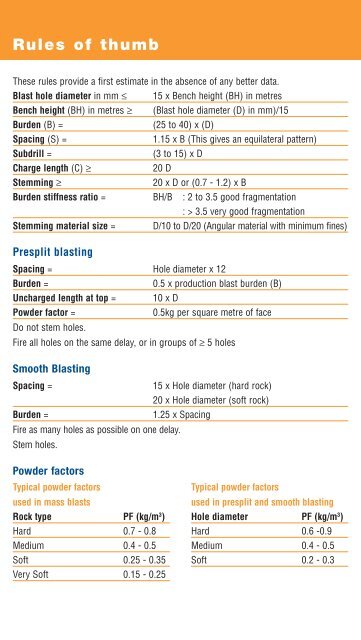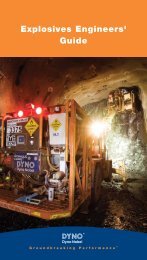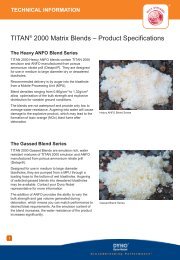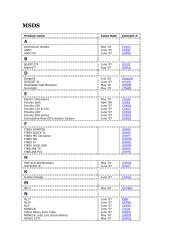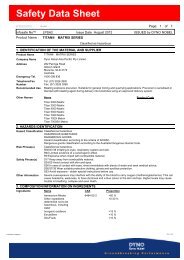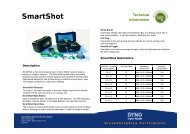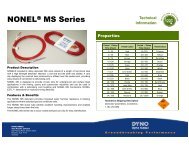Blasting and Explosives Quick Reference Guide 2010 - Dyno Nobel
Blasting and Explosives Quick Reference Guide 2010 - Dyno Nobel
Blasting and Explosives Quick Reference Guide 2010 - Dyno Nobel
You also want an ePaper? Increase the reach of your titles
YUMPU automatically turns print PDFs into web optimized ePapers that Google loves.
Rules of thumb<br />
These rules provide a first estimate in the absence of any better data.<br />
Blast hole diameter in mm ≤ 15 x Bench height (BH) in metres<br />
Bench height (BH) in metres ≥ (Blast hole diameter (D) in mm)/15<br />
Burden (B) = (25 to 40) x (D)<br />
Spacing (S) = 1.15 x B (This gives an equilateral pattern)<br />
Subdrill = (3 to 15) x D<br />
Charge length (C) ≥ 20 D<br />
Stemming ≥ 20 x D or (0.7 - 1.2) x B<br />
Burden stiffness ratio = BH/B : 2 to 3.5 good fragmentation<br />
: > 3.5 very good fragmentation<br />
Stemming material size = D/10 to D/20 (Angular material with minimum fines)<br />
Presplit blasting<br />
Spacing = Hole diameter x 12<br />
Burden = 0.5 x production blast burden (B)<br />
Uncharged length at top = 10 x D<br />
Powder factor = 0.5kg per square metre of face<br />
Do not stem holes.<br />
Fire all holes on the same delay, or in groups of ≥ 5 holes<br />
Smooth <strong>Blasting</strong><br />
Spacing = 15 x Hole diameter (hard rock)<br />
Burden = 1.25 x Spacing<br />
Fire as many holes as possible on one delay.<br />
Stem holes.<br />
Powder factors<br />
Typical powder factors<br />
used in mass blasts<br />
Rock type PF (kg/m3 )<br />
Hard 0.7 - 0.8<br />
Medium 0.4 - 0.5<br />
Soft 0.25 - 0.35<br />
Very Soft 0.15 - 0.25<br />
20 x Hole diameter (soft rock)<br />
Typical powder factors<br />
used in presplit <strong>and</strong> smooth blasting<br />
Hole diameter PF (kg/m3 )<br />
Hard 0.6 -0.9<br />
Medium 0.4 - 0.5<br />
Soft 0.2 - 0.3


